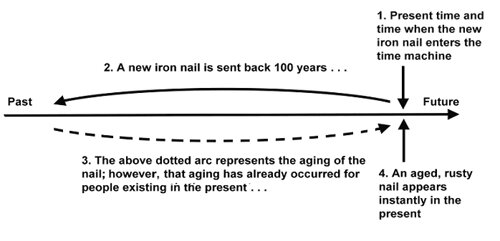Bad timing spoils the Terminator movies, argue Robert A. Delfino and Kenneth Sheahan
 Humans are addicted to metaphysical questions. Movies like The Terminator thrill us, in part, because they put flesh, blood, and special effects on metaphysical questions. Really, would you rather read what Aristotle has to say about the nature of time or watch Arnold Schwarzenegger travel through time and blow up everything in his path in 5.1 surround sound?
Humans are addicted to metaphysical questions. Movies like The Terminator thrill us, in part, because they put flesh, blood, and special effects on metaphysical questions. Really, would you rather read what Aristotle has to say about the nature of time or watch Arnold Schwarzenegger travel through time and blow up everything in his path in 5.1 surround sound?
Many things happen in films that are impossible in the real world, or that at least seem impossible. So we must often suspend our disbelief to enjoy a film. Still, there is only so much disbelief we can suspend before a movie starts to bother us. For example, finding a flaw in the storyline itself will often detract from our enjoyment of it – at least to some degree.
Unfortunately, from the perspective of metaphysics, there is a serious flaw in The Terminator which pretty much ruins the storyline. This may seem excessively picky, but we ask you to reserve judgment until you hear our arguments.
The problem concerns time travel. Our point is not to say that time travel is not possible, but to ask whether the elements of The Terminator make sense, given the assumptions that time travel to the past is possible and that the past and future can be changed.
The problem is about Kyle Reese, who must enter the time-displacement equipment in the future, sometime after the Terminator had already entered it. We call this the “Bad Timing Problem”: unless Reese entered at exactly the same time as the T-101, the rescue of Sarah Connor is either impossible or unnecessary.
During his interrogation by Dr. Silberman, a criminal psychologist, Kyle describes his entry into the time-displacement equipment: “The Terminator had already gone through. Connor sent me to intercept and they blew the whole place.” This might sound innocent enough, but time travel screws up the way things normally work. In order to understand the problem, first consider a long race, like the New York City marathon. Suppose you planned to enter, but overslept and started the race an hour late. Theoretically, you could still win. Sure, the other runners are way ahead of you, but they haven’t yet reached the finish line, so if you run fast enough you can pass them.
Using this marathon analogy, let’s suppose that after entering the time machine, it takes the Terminator six hours to find and kill Sarah Connor. If so, you might think that Kyle Reese has only six hours to enter the time machine and rescue Sarah. After all, if Sarah is already dead, then it’s pointless to travel back in time. As reasonable as this might sound, this logic can’t be applied in the case of The Terminator. The reason is this: changes in the past instantaneously affect the future. Consider the following thought experiment.
Suppose you have a time machine right in front of you and you set it to transfer an object one hundred years back in time to a spot only five feet from where you are now standing. Now suppose you drop a new iron nail into the time machine. Wham! It should appear instantaneously five feet in front of you, rusted and aged one hundred years (assuming no one moved it within that time span). The point is you won’t have to wait one hundred years for the nail to appear. This is because your sending the nail into the past will make its previous existence part of your time frame now. The nail will, of course, have aged. But since the aging of the nail was in the past relative to you, that period of aging has already passed. The fact that it appears instantly is what we call time compression (see the figure below).

Because Reese tells us that he went into the time machine after the Terminator, the T-101 will have either succeeded or failed in its mission before Reese enters the time machine. How, you ask? Pretend for a second that Reese never went into the time machine, but the Terminator did. In such a case, either the T-101 successfully kills Sarah Connor or, by some miracle, the police stop him. Whichever event takes place it will instantly affect John Connor and Reese in 2029 because of time compression. In other words, just as the iron nail appeared instantly when we dropped it into the time machine, so will the effects of the Terminator’s actions appear instantly. It seemed to make sense that Reese had up to six hours to save Sarah, but now this means that time doesn’t matter. If Reese goes in even one second after the Terminator, Reese can’t change anything. Either the T-101 has already killed Sarah, and thus doomed the human race, or it has failed, making Reese’s trip unnecessary.
You might raise the objection that two different scenarios could prove this conclusion wrong. First, what if Reese programmed the time-displacement equipment to go back to a time a few hours earlier than the T-101? This way he could get to Sarah before the Terminator arrives and thus prevent her murder. Second, we know from the sequels, Terminator 2: Judgment Day and Terminator 3: Rise of the Machines, that actually three Terminators and three Protectors were sent to different time periods. Thus, perhaps, the very existence of the sequels can save the first movie.
Unfortunately, neither of these ideas can save The Terminator from failing its metaphysics test. First, we know (from his own testimony) that Reese entered the time machine after the Terminator. Given how easily the T-101 kicks the crap out of the thirty cops in the police station, it’s likely that the Terminator will succeed in killing Sarah Connor. If so, given time compression, Reese will not even be able to enter the time machine! Why? Because if the Terminator is successful, then John Connor will never be born, the machines will win the war, and humanity will be extinct; this means that Reese is dead and he can’t ever enter the time machine, even to go back in time earlier than the T-101.
Second, what about the sequels? Even if the police managed to stop the Terminator from the original film, Skynet has other chances to exterminate humanity by killing John Connor as a teenage boy (in T2) and as a young man (in T3). However, in each of the sequels the Protectors enter the time-displacement equipment after the Terminators. Given time compression, and the fact that the Terminators of T2 and T3 are much more advanced than the original Terminator, it’s a safe bet that they’ll kill their targets, dooming humanity. With no humans left alive, no one will exist to reprogram the T-101s to protect John, and so no Protectors will enter the time machine.
If the Bad Timing Problem is real, then the storyline of The Terminator is very hard to believe. If we had to categorize the Bad Timing Problem, it would fall under what we call a No-F’n-Way flaw. If you can believe that ordinary civilians and police officers could have stopped the Terminator in time to save Sarah Connor, then good for you. We, however, doubt it.
This article is extracted and edited from Terminator and Philosophy: I’ll Be Back, Therefore I Am, edited by William Irwin, Richard Brown, Kevin S. Decker, part of Wiley-Blackwell’s Philosophy and Popular Culture series.
Robert A. Delfino is assistant professor of philosophy at St. John’s University, where Kenneth Sheahan is an honors student.
 Email This Post
Email This Post 



After the Terminator goes back in time and nothing changes, Reese could deduce that the Terminator has already failed, but he doesn’t know whether it failed because he will go back and stop it, or for some other reason (say a bug in the Terminator’s software). Reese is now left wondering if he now goes back and stops the Terminator, or he now doesn’t go back to avoid the risk that he might change history by somehow inadvertently leading the Terminator to Sarah Connor. Reese might even fear that the very instant he drops the intention to go back and stop the terminator history will change, and so somewhat reluctantly he goes back not knowing whether he should have done so - thus providing genuine drama.
John Connor can’t be stopped by going back in time to kill him. Skynet sends terminators back in time to kill John Connor only if John Connor is alive. If he is dead, they wouldn’t bother sending terminators to kill him, if he is alive, he must have survived any attempts made on his life in the past. Or does the timeline somehow fold like a Z? but then there has to be 2 points in time where John Connor was a teenage boy, one where he is a rebel teen, and one where he is fighting robots from the future. And also 2 versions of 2029, one with John Connor fighting robots who try to kill him in the past, and one where he died long ago because the robots killed him in the past. In this Z-fold, Connor has time to go in after the terminator to save himself, but the skynet’s attempt would be futile since it would only change this second instance of this section of the time line. If it did Z-fold, the first movie takes place in the second instance of his childhood. If it doesn’t Z-fold, the skynet can’t succeed, because their success leads to a paradox: They will kill him today, if he is alive tomorrow. And if they fail, skynet would know that it would fail when they sent the terminators back in time. This Z-fold would mean that there are 2 dimensions of time, time is a ribbon rather than a line, not like a tree with branches, because it would be possible to jump back to the original time instance. And even if the skynet succeeded, John Connor would still be alive in this second instane of time, because he is from a different instance on the time ribbon. Imagine 2 tracks. 1 is the original, 2 is the one that Connor and the terminators jump to in the Z-fold. in 1 he becomes a leader of the resistance against skynet. When they go back in time, they also have to jump to 2, hence the Z. If skynet succeeds in 2, this won’t undo Connor, because he is from 1, where he wasn’t killed. He would have to have been killed in 1 in order to be undone. But this leads to the paradox.
So, either the skynet is stupid, or time is 2 dimensional. Either way, Connor can’t be undone by killing him in the past.
But this is not what I was supposed to do, I was supposed to write an essay on Quine
i will state that the third terminator was a nightmare… and that the improbability of change is infinite, so the franchise is a shotty rep. but the idea of time is that … what oh, wait a moment… there we are… distance… no … if you look at mass as scale of … than time is like void, a hole, just a hole, not the idea of black, that would be the direction that the world would take if the people ever discovered a machine to move about in time instead of using their minds, i mean remember the Michael J. Fox movie which is like the Stan Lee Marvel, Dc conflict Infinity… with multiplicity comes dynamic…not singularity… as dynamic is not multiplicity simply come on hollywood i suggest Primer for a time travel flick right up there with H
g wells orson …